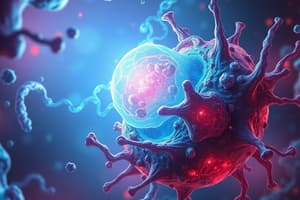Podcast
Questions and Answers
Which of the following best describes hypertrophy?
Which of the following best describes hypertrophy?
- Reversible change in which one adult cell type is replaced by another
- Increased number of cells in an organ or tissue
- Decrease in the structural components of the cell
- Increased size of cells and the organ (correct)
Which of the following is an example of metaplasia?
Which of the following is an example of metaplasia?
- Fibrocystic disease of the breast
- Pressure atrophy (aneurysm, amyloidosis of liver)
- Excessive growth factor sensitivity
- Gastric to intestinal epithelium transformation (correct)
What represents a reduction in the structural components of the cell?
What represents a reduction in the structural components of the cell?
- Metaplasia
- Atrophy (correct)
- Hyperplasia
- Hypertrophy
What is the main characteristic of atrophy?
What is the main characteristic of atrophy?
Which condition involves an increase in the number of cells in an organ or tissue?
Which condition involves an increase in the number of cells in an organ or tissue?
Which cellular adaptation involves a reversible change in which one adult cell type is replaced by another adult cell type?
Which cellular adaptation involves a reversible change in which one adult cell type is replaced by another adult cell type?
What is the main cause of atrophy known as disuse atrophy?
What is the main cause of atrophy known as disuse atrophy?
Which cellular adaptation involves an increase in the number of cells in an organ or tissue?
Which cellular adaptation involves an increase in the number of cells in an organ or tissue?
What is the main cause of atrophy known as loss of innervations?
What is the main cause of atrophy known as loss of innervations?
What are the 4 main forms of cellular adaptation mentioned in the text?
What are the 4 main forms of cellular adaptation mentioned in the text?
Which of the following is NOT a cause of atrophy?
Which of the following is NOT a cause of atrophy?
What histologic changes are associated with atrophy?
What histologic changes are associated with atrophy?
Which of the following is a plausible example of metaplasia?
Which of the following is a plausible example of metaplasia?
What represents an undesirable change if persistent, as it can lead to cancer transformation?
What represents an undesirable change if persistent, as it can lead to cancer transformation?
Which cellular adaptation involves an increase in the size of cells and the organ without new cell formation?
Which cellular adaptation involves an increase in the size of cells and the organ without new cell formation?
What is the main cause of atrophy known as nutritional atrophy?
What is the main cause of atrophy known as nutritional atrophy?
What is a plausible example of hyperplasia?
What is a plausible example of hyperplasia?
In what condition does the left ventricle of the heart show hypertrophy?
In what condition does the left ventricle of the heart show hypertrophy?
What condition involves bone formation in muscle, such as in myositis ossificans?
What condition involves bone formation in muscle, such as in myositis ossificans?
"Brown atrophy" is associated with which organ?
"Brown atrophy" is associated with which organ?
Which of the following best describes atrophy?
Which of the following best describes atrophy?
What represents a reduction in the structural components of the cell?
What represents a reduction in the structural components of the cell?
What are the 4 main forms of adaptation mentioned in the text?
What are the 4 main forms of adaptation mentioned in the text?
Which cellular adaptive responses can occur at any of these steps: Receptor binding signal transduction protein transcription translation export?
Which cellular adaptive responses can occur at any of these steps: Receptor binding signal transduction protein transcription translation export?
Which condition involves an increase in the number of cells in an organ or tissue?
Which condition involves an increase in the number of cells in an organ or tissue?
What is the main cause of atrophy known as disuse atrophy?
What is the main cause of atrophy known as disuse atrophy?
Which of the following is an example of metaplasia?
Which of the following is an example of metaplasia?
What is the main characteristic of atrophy?
What is the main characteristic of atrophy?
What are the biochemical mechanisms involved in atrophy?
What are the biochemical mechanisms involved in atrophy?
Which cellular adaptation involves a reversible change in which one adult cell type is replaced by another adult cell type?
Which cellular adaptation involves a reversible change in which one adult cell type is replaced by another adult cell type?
What represents changes in the cell environment when the cell adaptive capability is exceeded?
What represents changes in the cell environment when the cell adaptive capability is exceeded?
What represents a new steady state resulting from cellular adaptive responses?
What represents a new steady state resulting from cellular adaptive responses?
Flashcards are hidden until you start studying
Study Notes
Cellular Adaptations
- Hypertrophy: an increase in the size of cells and the organ without new cell formation
- Metaplasia: a reversible change in which one adult cell type is replaced by another adult cell type
- Atrophy: a reduction in the structural components of the cell
- Hyperplasia: an increase in the number of cells in an organ or tissue
Causes of Atrophy
- Disuse atrophy: caused by lack of use or inactivity
- Loss of innervations: caused by nerve damage or disruption
- Nutritional atrophy: caused by malnutrition or starvation
Examples of Cellular Adaptations
- Metaplasia: replacement of ciliated epithelial cells with squamous epithelial cells in response to smoking
- Hyperplasia: increase in the number of cells in the uterus during pregnancy
- Hypertrophy: increase in the size of muscle cells in response to exercise
Atrophy
- Characterized by a reduction in the structural components of the cell
- Histologic changes associated with atrophy include a decrease in cell size and number
- Can be caused by disuse, loss of innervations, or nutritional deficiency
Other Conditions
- Myositis ossificans: a condition involving bone formation in muscle
- "Brown atrophy": a condition affecting the heart, characterized by heart muscle cells being replaced by fatty tissue
- Left ventricular hypertrophy: a condition in which the left ventricle of the heart becomes thicker in response to high blood pressure or other conditions
Studying That Suits You
Use AI to generate personalized quizzes and flashcards to suit your learning preferences.




